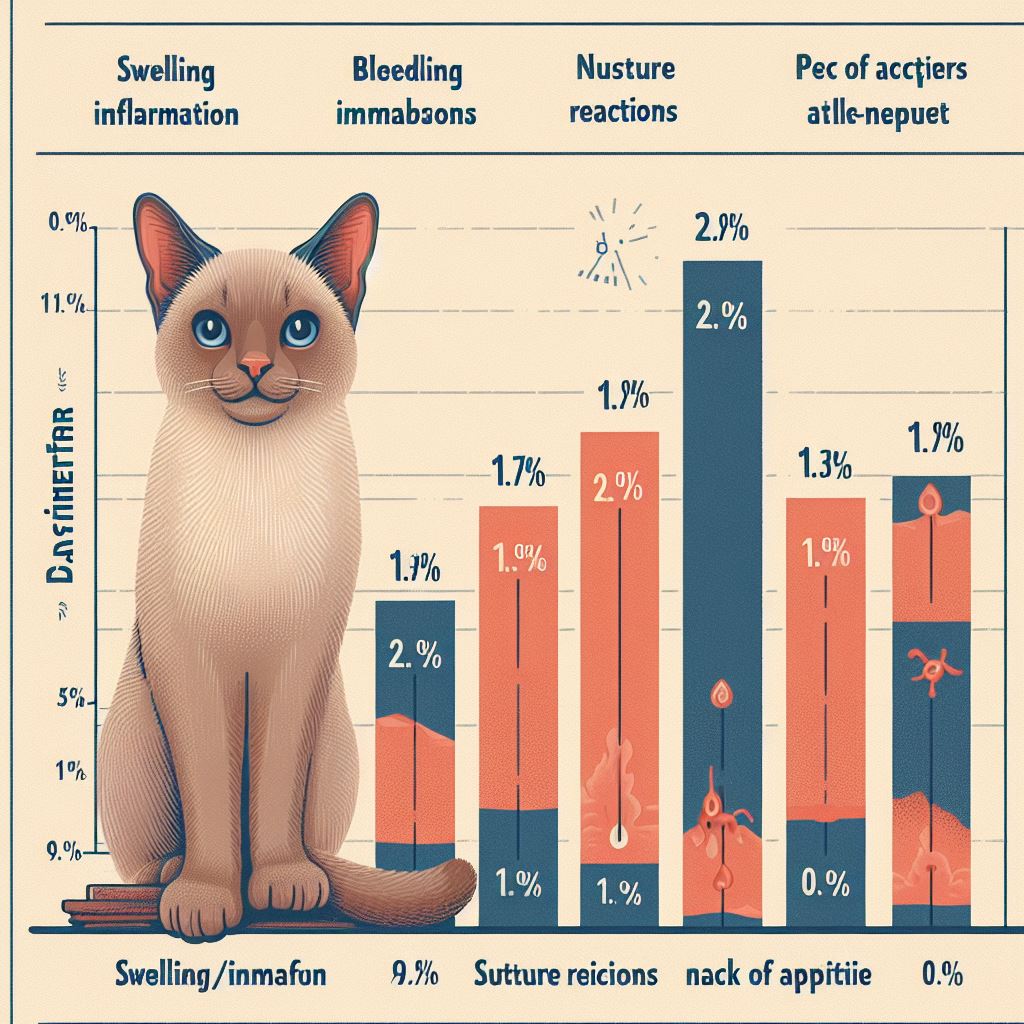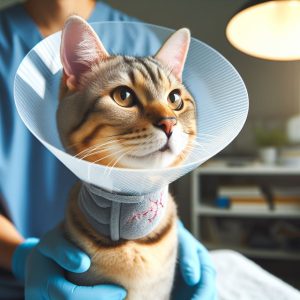Neutering—the removal of a male cat’s testicles—is a routine surgery, but infections can sometimes occur during recovery. As a caring cat owner, being vigilant about signs of infection is key to ensuring your feline friend heals properly after the procedure.
In this article, we’ll cover:
- Common types of neutering infections
- 12 symptoms that may indicate infection
- Preventative care during recovery
- When to call the vet
- Treatment options for post-neuter infections
I’ll also share recovery tips, real-world examples, and the insights I’ve gained from my own cat’s neuter experience. If you know what to watch for, you can catch post-surgical infections early and help your cat return to his usual self quickly.
It’s Rare, But Infections Can Develop After Neutering
Neutering is a very common, quick procedure, especially for adopted shelter cats. By some estimates, upwards of 90% of owned male cats in the US are neutered.
The surgery removes the testes through a small scrotal incision, typically with dissolvable sutures. It’s much less invasive than spaying female cats. As such, complications are infrequent.
However, local infections, abscesses, and other issues can develop in a small percentage of cases, even when proper surgical protocols are followed.
Infection Statistics: How Likely Are Complications?

A 2010 study in the Journal of Feline Medicine and Surgery looked at complications among over 5,000 cat sterilization procedures at various veterinary clinics.
The results?: 7.3% of cats experienced some type of complication, though most were minor. The most common issues were:
- Swelling/inflammation: 2.8%
- Bleeding/hematomas: 1.7%
- Suture reactions: 1.3%
- Lack of appetite: 0.9%
Additionally, less than 1% of cats developed an infected neuter incision site.
So while full-on infections are fairly rare, some level of complications can occur. Neutering is almost always beneficial for male cats in the long run. But owners should monitor the incision area closely, especially in the first 2 weeks post-surgery.
Watch For These Signs of Infection After Your Cat’s Neuter
Infections can arise from bacteria entering the incision during surgery, or afterwards from licking/scratching. Usually clear symptoms arise.
Here are 12 indicators a post-neuter infection may be developing:
1. Excessive Licking of the Incision Area
Licking is an instinctive cat behavior. Admittedly, keeping the site clean promotes healing.
However excessive licking can open the surgical wound. It also introduces bacteria from your cat’s mouth into the area.
If the kitty fixates on licking his incision for long periods, take notice. It likely signals discomfort and possible infection brewing.
2. Redness Around the Incision
Some post-surgical redness and swelling are normal as the scrotum heals. Discomfort and inflammation from internal healing can also cause light reddening.
However, if the skin redness spreads, intensifies over 2-3 days, or is very dark red, an infection probably took hold.
Pro Tip: Check not just the incision but the surrounding scrotal area as well. Spreading redness indicates bacteria infiltrating tissue around the wound site.
3. Swelling of the Scrotum
A slightly swollen scrotum often occurs after neuter surgery, resolving within 1-2 weeks. The swelling results from internal healing processes and mild inflammation.
But if swelling seems excessive—the scrotum balloons to double or triple its normal size—suspect an infection. Similar to the above, increasing swelling over several days points to a brewing skin infection.
4. Discharge From the Incision Site
You may see a small bit of blood-tinged fluid immediately after surgery. However, any sizable discharge emerging later on likely means infection.
In particular, yellow or green discharge signals pus from white blood cells fighting bacteria. Some cats also develop a foul-smelling discharge when infections take hold.
5. Unusual Changes Near the Incision
Along with the above symptoms, subtle skin changes around the incision can mark infection. Signs include:
- Rash or pimples
- Crusting scabs
- Blisters and lesions
- Hair loss in the area
These denote inflammation reactions as your cat’s immune system responds to contaminants entering the wound.
6. Decreased Appetite
It’s common for recently neutered cats to eat less than usual for a day or two after surgery. The medications and effects of anesthesia suppress appetite.
But if decreased appetite and lethargy persist more than 48 hours post-surgery, it often links to post-neuter complications like infection.
7. Poor Wound Healing
By 5-10 days after surgery, neuter incisions should show clear signs of mending redness fading, swelling decreasing, and scabs diminishing.
If the wound area looks nearly as bad (or worse) than a few days prior or fails to heal after 2 weeks, consider infection likely.
8. Reopened Wound/Bleeding
In rare cases, significant bleeding indicates a post-surgery hematoma. But later reopening or bleeding likely means infection eroded the surgical closure.
Along with our cat Luna’s neuter, the vet advised us to immediately contact her if any renewed bleeding occurred because it strongly indicates problems healing internally.
9. Lethargy/Hiding Behavior
Cats instinctively mask symptoms when hurt or sick to avoid appearing weak. So if your once-playful feline starts hiding for long periods and acting lethargic after his neuter, suspect something is wrong.
Take a close look at the incision site and monitor for other infection indicators. Lethargy and withdrawal often link to discomfort from brewing infections.
10. Reluctance to Move Hind Legs
Neutering surgery affects male cats’ groin and hind regions directly. Your cat may move slower than usual for a day or so afterward.
But if pronounced, lasting difficulty walking, jumping up, or reluctance extending the hind legs continues, it likely indicates post-surgical complications. Infection could be causing additional pain and inflammation.
11. Fever/Chills
Though less common than other symptoms here, post-neuter infections can sometimes create fever and chills. Technically any temperature over 102.5°F qualifies as fever in cats.
If you suspect fever or chills, take your cat’s temperature rectally using a pet thermometer. This offers the most reliable reading. And contact your vet promptly if it’s over 102.5°F.
12. Incision Area Feels Hot
Finally, another clue to brewing infection is if the skin nearest the incision feels hot and tender to the touch. Heat and sensitivity in the area denote inflammation.
So along with taking your cat’s temperature if concerned, gently run your finger along the shaved incision region. See if it feels abnormally hot compared to the kitty’s body further away from the site.
Pro Tip: Set a reminder to carefully check your cat’s incision daily, including feeling for unnatural heat. Early infection detection improves outcomes drastically.
6 Ways to Prevent Infection After Neuter Surgery

While post-neuter infections remain uncommon in general, you can further reduce risks by taking proper aftercare steps:
1. Use an E-Collar or Recovery Suit
The notorious cone-shaped “e-collar” restricts licking and scratching at incisions. Newer versions are less cumbersome than traditional cones.
But many owners find recovery bodysuits, available online or at pet retailers, more comfortable and less stressful for kitty. Just ensure whichever device you choose adequately prevents access to the incision.
2. Follow All Discharge Instructions
Vets usually prescribe 7-10 days of pain/anti-inflammatory medications after neutering to control discomfort. Be diligent giving all prescribed medications as directed during recovery.
Following instructions for care of the surgery site is also vital—usually keeping it clean and dry. Bandages that cover the area may be applied temporarily after the procedure as well.
3. Limit Activity & Supervise Your Cat
Try to restrict activity and jumping during initial healing, which takes 10-14 days. Stop excessive licking when seen. Place food, water, and litter in easily accessed areas.
And despite our best efforts, some cats are Houdinis wriggling out of e-collars! So check incisions at least twice daily and confine kitty when away if needed.
4. Get Issues Treated Promptly!
This one can’t be overstated: If any symptoms above emerge, or if the incision looks questionable, contact your veterinary office immediately!
Getting post-surgical problems diagnosed and treated ASAP makes a huge difference in complications and recovery outlook. So don’t delay seeking help.
5. Consider Laser Surgery
More vets now offer laser neuter procedures, which are pricier but involve less bleeding risk and faster healing than traditional neuter surgery.
If concerned about infection risk factors for your cat, ask your vet about availability of laser neutering. It’s growing in popularity exactly because it minimizes complications for feline patients.
6. Have Bloodwork Done Beforehand
For geriatric or sickly cats, vets may run blood tests beforehand to spot existing issues that could slow recovery or raise infection risk.
So for higher-concern patients, ask your vet to assess pre-surgery bloodwork to rule out complicating health factors beforehand. This allows optimizing your kitty’s surgical prep.
Real-World Example: Our Cat Luna’s Post-Spay Complications
When our newly adopted cat Luna was just 6 months old, she underwent spay (ovary removal) surgery. Despite following all post-op directions diligently, she developed an infected abdomen.
Luna became extremely lethargic, cried when touched and ran high fevers starting about 4 days after surgery. She required strong antibiotic injections and weeks more recovery than expected. It was scary!
In hindsight, the spay incision looked somewhat red on day 2. But having never owned a cat before, we weren’t sure what was normal. Now we know to diligently watch for any worrying symptoms or repetitive licking during surgical recovery. Reacting immediately could have prevented some hardship for sweet Luna!
When to Call Your Vet About Post-Neuter Infection
Based on the symptoms above, when exactly should you contact your vet regarding a potential neutering infection?
Here are 5 times to call without delay:
1) Obvious discharge, bleeding, or reopened incision
2) Significant swelling, redness lasting over 3 days
3) Any fever over 102.5°F
4) Decreased appetite/lethargy more than 48 hours after surgery
5) Symptoms get worse or fail to gradually improve after 5-7 days
Again, don’t hesitate—infection risks rise the longer you wait! Brief post-op issues are common. But if anything seems “off” or excessively painful days later, your cat needs an exam.
Treating Post-Neuter Infections: Antibiotics, Topicals, Aftercare
Treating neutering infections aims to clear infection-causing contaminants and ease discomfort until healed. Vets may prescribe:
Oral antibiotics to combat bacterial infections internally
Topical antibacterial ointments are applied directly around the infected neuter incision
Anti-inflammatory medications to reduce swelling, irritation, and pain
Elizabethan collars to prevent licking and additional damage
In some cases, infected tissue may need to be drained or dead skin debrided. Avoid any home remedies like hot compresses or honey without vet approval.
With treatment, most cats recover fully within 1-2 weeks as antibiotics tackle infection and the wound finally closes up properly. Just ensure you give all medications as directed until the regimen finishes.
12 Key Takeaways: Monitoring Post-Neuter Infection Signs
Hopefully, this guide gave you a thorough overview of signs, prevention methods, and treatment approaches related to possible infections after your cat is neutered.
Here are 12 crucial points to remember:
- Infections are fairly rare after neutering, but owners need to monitor cats closely, especially in the first 10-14 days post-surgery.
- Excessive licking of the incision area is problematic and may open the surgical site to contaminants.
- Dark red skin, spreading redness, and swelling suggest inflammation and infection setting in.
- Any yellow/green wound discharge indicates the likely presence of infection.
- Subtle changes around the incision like hair loss or blisters also mark developing infections.
- Decreased appetite past 48 hours postoperative often links to complications like infection.
- Wounds that fail to gradually heal or reopen likely have infections impeding proper healing.
- Fever over 102.5°F, lethargy, and trouble moving hind legs all require prompt veterinary checks.
- Using e-collars, recovery bodysuits, and supervised confinement helps prevent incision infections during post-op recovery.
- Have your vet examine any incisions that look questionable—don’t delay! Early treatment is hugely beneficial.
- For at-risk cats, pre-surgery bloodwork and laser neuter procedures can minimize the chances of post-op issues.
- When in doubt about symptoms, call your veterinary office for advice—they want to ensure proper healing!
I hope this guide gives you confidence in knowing what to watch for after your cat’s neuter. Here’s to an easy, infection-free recovery for your feline buddy!




